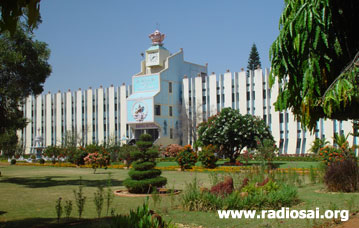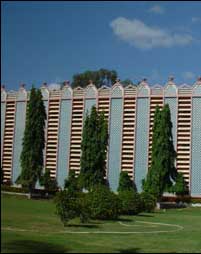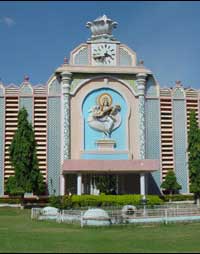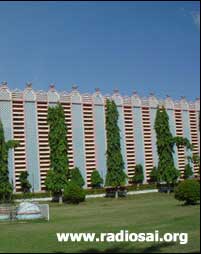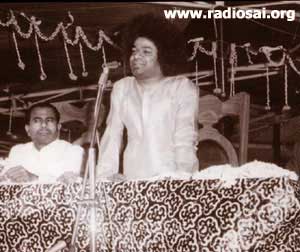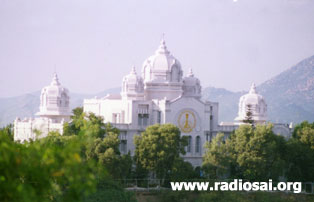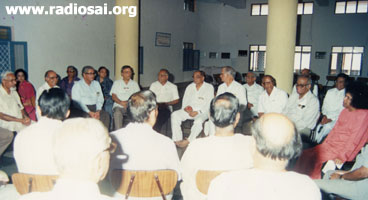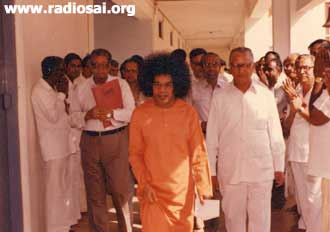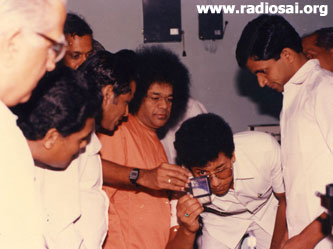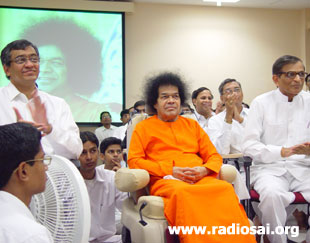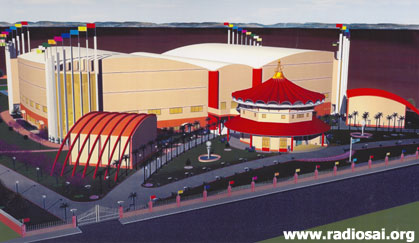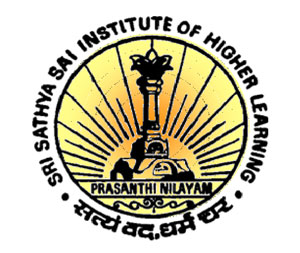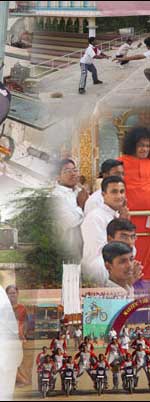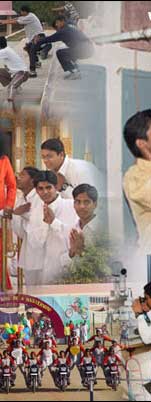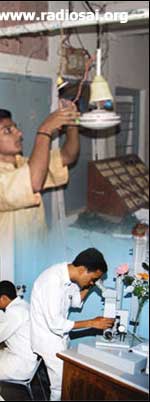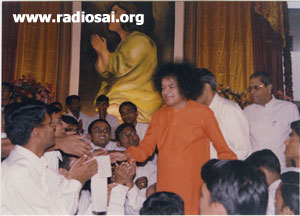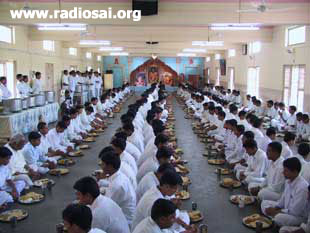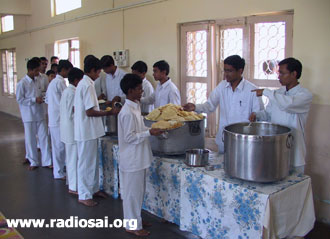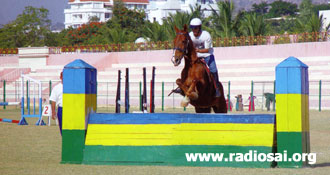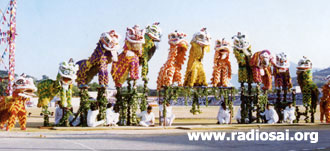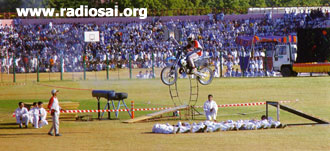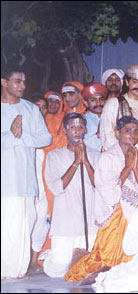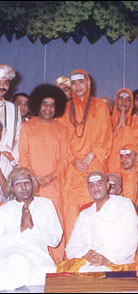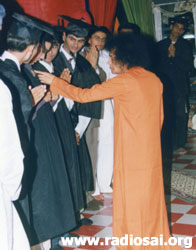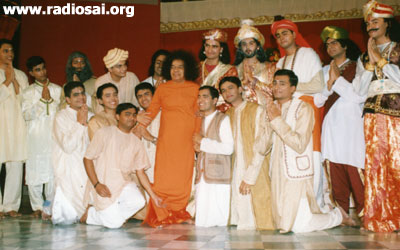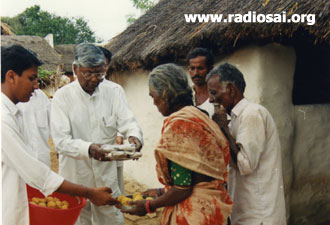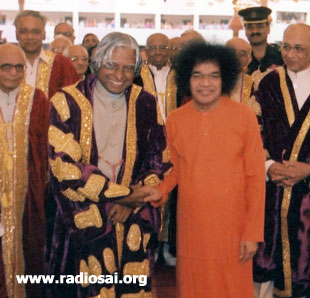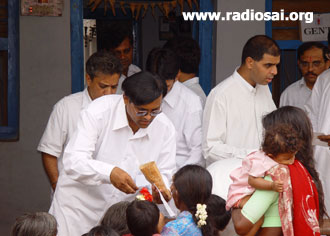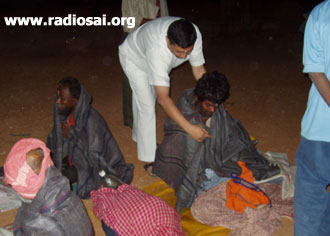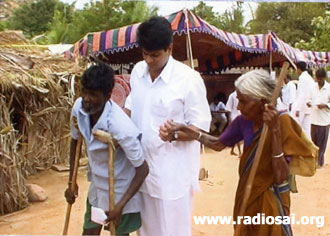A Tale from a Tough World
“It was not even nine months since I had completed my MBA when I was deputed to Jalgaon District Milk Producers Co-operative Milk Union Ltd. as Head of Sales and Marketing functions. It was a very heady feeling to lead a group of 30-35 people,” says Jasti Vamsee Krishna. Vamsee was sent to Jalgoan in Maharashtra state by the National Diary Development Board to head the Marketing wing – the most dreaded in the Milk Unions. It was indeed heady because apart from working hours stretching from early morning to late-nights, he now had to manage a team of people who were the toughest nuts to crack in the organisation – the leaders of workers’ unions and other heavyweights. In fact, being posted in the marketing wing was always considered a disincentive. “I was told that heading the marketing wing was one of the nightmares and one should avoid the posting as far as possible,” Vamsee says. “The leaders of almost all the unions were in my wing. Most of the rival union leaders would be reporting to me. When I entered the office for the first time, I was welcomed with stern stares from them. I knew I was the most unwelcome addition there.”
Before Vamsee realised what was happening, his office door flung open and with lightning speed, somebody barged into his chamber. The much feared short and stout firebrand was right in front of him. Courtesies like asking for permission to see an officer, listening civilly to what the boss says, etc., were not for him. Whatever he did – whether right or wrong – was the perfect way to go about in life. He was the rule. He had proved this a million times.
“What is my work?” he ordered in a brusque voice in his abrasive Hindi while holding out his relieving order. Vamsee was absolutely clueless. It was like a scene from a horror movie.
Unaware of his posting and with completely no idea of what kind of task to assign to an employee of his nature, Vamsee politely asked him to wait outside for a few minutes, which the hot-headed leader fortunately obliged. Vamsee then began his homework. He called his deputy to comprehend the situation and discuss what work could be allotted to him.
|
|
|
A confrontation can easily spiral out of control |
|
Recalling his deputy’s caution, Vamsee says, “I received my first ever shocking advice from him. He told me, ‘Sir, do not give him any assignment. Just send him back to the Personnel Department. We cannot handle him. He will be a big bag of trouble and this marketing section will become a mess if we have him here.’
 |
Making decisions with a calm mind |
|
|
But Vamsee did not heed his deputy’s advice. Instead, he asked for the personnel file of the union leader. Sitting outside, the union leader’s malicious temper only got worse when he saw his file being taken into the room. Vamsee quickly scanned the file. It was full of memos and reprimands, though he had performed his job on many occasions. After a few silent moments with himself, Vamsee called the union leader in. The man was like an incensed tiger who had already sensed danger and was about to pounce. He surmised he was not going to get any assignment and was ready for combat.
As soon as he got in, he blurted out, “So you have seen my file. You know all about me. You do not have any work for me, right? I know all you managers. Systematically you people have tortured me for years now…..” He went on. There was no break. He had been transferred four times in the last sixteen months. Nobody wanted him. Finally, he said, “I know your decision. I know what you people think. Shall I go back then?” He was anger and frustration personified.
|
Vamsee absorbed all the fury. He was as calm as he could be. After he exhausted his grievances and grouses and all his fiery waves had subsided, Vamsee gently persuaded him to take a seat and offered him water. Then, in a concerned tone, he asked, “Are you willing to work with me?” The fifty plus union leader was completely taken aback. “Your personnel records are perfectly fine with me,” Vamsee continued. “You have always delivered when it mattered. I have absolutely no question about your capabilities. Regarding other behavioural aspects of your personality, they are very subjective and I do not want to go by what others have said. To me, you are a very competent person. Tell me, will you work with me? What is the work you think you can do to the best of your ability?”
In his decades of association with the company, not a single officer had ever spoken to him so endearingly. Like a tiger that had completely surrendered, he said, “I would do any job that you give me, sir.” As much as Vamsee was shocked earlier by his ferocity now he was moved by his vulnerability. Vamsee then explained to him that he had recently been deputed to the unit and once he settled down in his new job, he would give him a suitable offer. The union leader left his office an antithesis of his former self. But before he left, he impressed upon Vamsee that he was basically a good-natured man.
A few days passed, and Vamsee gave him some simple daily tasks which the past-middle age union leader performed quite well. During February 1999, Vamsee’s organisation faced many difficulties in logistics. There was a new problem every day. Midnight was when the dispatch dock of his unit had to perform certain important operations and no one was willing to work during those unearthly hours. It was a job that brought no credit to the employees for the work done or for the efforts made. If the assignment was forced upon someone, he always did a half-hearted job and for Vamsee it often meant sleepless nights. At a loss to find a solution, Vamsee suddenly thought of the union leader. He called for him and asked, “Are you willing to take this job?” He made it clear that he was assigning him the job purely because he had complete trust in him and felt he was competent to handle the crucial operation. The late hours of the work were not meant to victimise him.
The union leader was immediately game for it and what he said next left Vamsee bowled over. “Sir, till now, any person who has spoken to me in this organisation has always assumed that I am a troublemaker. No one respects me or my abilities and I am always looked upon as a liability – the sooner you get rid of him the better. You are the first one to talk to me in such a friendly and obliging way. I will definitely do this task for you”. Vamsee’s peers warned him of the grave risks of entrusting the responsibility of such a crucial operation to a rebel, but Vamsee stuck to his decision.
|
|
|
Building trust through communication |
|
From then on, what happened became part of the company’s folklore. The old but experienced employee took charge of logistics, analysed the whole operation, suggested out-of-the-box ideas, convinced Vamsee about his new methods, and in a short time brought sweeping changes to the whole operation. The system evolved by him continues even today. This union leader is now looked upon by the management of the company as a valuable asset. He has all the support he needs to further improve the company’s operations. Vamsee Krishna, according to the top management, had performed a miracle. Special acknowledgements flooded in from the head of the institution.
Henceforth, whenever unions and management were at the negotiation table, rather than heated exchanges there was now a conscious effort from both parties to come to amicable solutions. When Vamsee moved to Hyderabad to work for a different organisation (Reliance Industries Ltd.), the union leader made a special visit to Hyderabad just to meet his previous boss and convey his gratitude. Even now, be it Diwali or the New Year, he never forgets to call Vamsee and offer a warm ‘Happy Diwali, Sir’, ‘Happy New Year, Sir’, ‘How are you doing?’
Isn’t this heartening?
That was Vamsee’s story; now let’s go to another account. This one is about Vidyadhar, again in the corporate world, but in an altogether different setting.
“Live and Let Live”
“It was the final negotiation for a bid that our company had put in for providing soundproofing equipment for a large genset (power generator) room for one of India 's most prominent home-grown IT giants. Our company was short listed as being technically best suited for the job. The price was the only criterion that was against us,” narrates Vidyadhar, Director of Lotus Energy Systems based in Bangalore.
 |
Holding on to his Philosohy of Work |
|
|
“In keeping with the internal standards set for ourselves,” he continues, “we had prepared a detailed costing and had to draw a line where it became unviable. The Purchase Officer was saying that they would like to give us the order but, he said, "You will have to come up with a price that is twenty-five percent lower or we will be forced to give the project to your competitor." Pulling out my costing sheet, I went through the items that we had proposed in the absence of a detailed technical specification one by one and explained the repercussions on the performance if this element was removed from the proposal and these were the cost components, overheads and this was our margin.”
The officer went through the list in great detail. "Your explanations and working sheets appear impeccable, but how is it that your competitor has given a written assurance stating that the performance will be the same as yours at the thirty percent lower price?" Vidyadhar stated, “I can only comment on what we submitted and would like to reserve my comments on someone else's proposal." |
He pointedly asked me, ‘Will you stick by your proposal or can you look into it once again and drop the price?’ I replied, ‘We need this job to survive, but we cannot trim the scope to give you a lower project cost. To do so, we would have to offer a substandard solution and then pray that things work out somehow.’ As a final rejoinder, I said, ‘I believe I have given you the best solution possible and at the best price I can offer it at. Beyond this, it is totally your prerogative.’
The Purchase Officer became reflective for a few seconds and then asked curiously, ‘What is your philosophy in negotiation?’ I didn't quite know what to make of it or what to say. So I said the first thing that came to mind – Do your best and leave the rest, if it has to happen, it will. That is our philosophy. ‘And if it means that you lost the order?’ he queried. I said by reflex, Dharmo Rakshathi Rakshitha (Righteousness Protects the Righteous). He stood up signalling that the meeting was over. But before he left, pumping my hand, he said, ‘That is exactly what our Chief Mentor said many years ago when he had the biggest deal for our company from a multinational account before him across the negotiation table. Don't worry about this job, stick to your philosophy and it will ultimately pay off.’
“We expectantly waited for the officer’s response. Two days passed and we found out that we had lost the job. It was a sick feeling in the gut and a major blow to our company. We were shattered. We did a lot of brainstorming and soul searching after that: Did we do something wrong? Is it wise to be so rigid in a fiercely competitive world? Are we being hard headed instead of being smart and hardnosed? These conflicts kept whirring within.
“Then, a year or so later, something very interesting happened. Out of the blue we got a call from the same Purchase Officer asking us to come in the next day. He didn't even mention what it was about – it was just a terse message – ‘Come tomorrow at 11:30.’
|
|
|
Righteousness protects the righteous |
|
We went there. ‘We sat across the same table a year ago,’ the Officer said. ‘I have not forgotten that day and that is the reason I called you.’ He then showed us a plan for a TV broadcast studio and asked, ‘Can you do the acoustics for this project for us?’ I said, ‘We haven't done something like this before.’ ‘But can you do it?’ he asked again. He seemed eager to deal with us. I said, “Yes”.
“After a lot of homework, we put our bid in two days later. Not even two hours after sending in our proposal, we were faxed the Purchase Order. We were dazed. Wow! No negotiation called for. It was unbelievable. And then we got another terse message – ‘Start work immediately!’
“How did all this happen? A few weeks later I ran into the Purchase Officer on site and after thanking him for the contract asked, ‘How is it that there were no negotiations this time around?’ With the benign disposition of a spiritual seeker, he said, ‘The last time around I learned a difficult lesson the hard way. That has changed my philosophy of negotiation. Instead of “Live and Let Die”, now I believe in “Live and Let Live.”
“From that day on, we have done a great deal of work for the facilities infrastructure of this one company across the country without ever having to sit across the negotiation table again.” Vidyadhar concludes his scintillating story. There is a rare sense of fulfilment in his being. His persistence with his beliefs had ultimately paid off.
Sri Venkatesh Prasad, who is currently the CEO and Director of Trayee Impex Pvt. Ltd., has a similar story to narrate.
Respect and Reward
Venkatesh, in his previous work assignment, was given independent charge of a loss-making unit in the business group and was assigned the task of reviving it. He was also given a free hand to change any of the staff so as to turn it around and attain profitability.
|
Swami's students stand out in society |
|
|
At the end of two and half years, Venkatesh says, “We had turned profitable, repaid all the outstanding loans to banks and had declared a dividend for the first time in two decades. To cap it off, we had a very healthy bank balance. Throughout this phase, I did not change any of the staff or the workers.” So how did he achieve this feat? Venkatesh gives a revealing instance.
“One of the key personnel I was involved with was an accountant who was over sixty. He had retired from service but I asked him to continue in order to help me tide over the crisis. I valued his experience and treated him with a lot of respect. I trusted his ability in spite of his age.” But at the same time, from an organisational point of view, Venkatesh ensured that a second line was in place and that the older man’s presence did not discourage the young employees, so the company was in no way disadvantaged. One evening, months later after the company had its turn around, when Venkatesh was sitting across from the accountant’s desk, the older man stunned him to silence when he said, “Sir, thank you very much”. There was a smile of satisfaction on his face and continued, “You have behaved in this way because you are a Baba student”. Venkatesh was dumbstruck. “In all those years, I never mentioned to any of the staff in the unit about my academic background or Swami. I was amazed. I didn’t know how to respond.” |
“This university must be distinct from the rest and attain a unique status” - Baba
Yes, Venkatesh was a Baba student and that is the common thread that runs through all the stories narrated above. Like Venkatesh, Vidyadhar and Vamsee too were beacons of light from the same glorious edifice of learning – the Sri Sathya Sai Institute of Higher Learning.
One score and five years ago when Bhagavan Baba unfurled this model Institute to the world on the eve of His fifty-sixth Birthday, addressing the mammoth assembly on that momentous morning, He said,
“You are aware that there are now 108 universities in India. This University is the 109th, one more than that traditional total. May all the universities succeed and serve the country well. But this university must be distinct from the rest and attain a unique status.”
|
|
|
Why another University? - The Visionary Chancellor |
|
As we see so many Vidyadhars, Vamsees and Venkateshs pass out of this hallowed Institute every single year; as we hear the University Grants Commission’s Peer Team announce that “the Institute stands out as a Crown Jewel in the University system of Education in India”; when we hear the President of India, Sri Abdul Kalam say, “Is value-based education possible? Sri Sathya Sai Institute of Higher Learning has given an answer in the affirmative”; as we see multinational banks and premier business corporations conduct special interviews just for the Institute students year after year; as we hear Sri Venu Srinivasan, CEO of TVS Motors, say, “I have seen these boys come to our factory many times over the last many years. Their conduct and their brightness – these are two things that always impress you. You can see character in these boys”; when you see the National Level Committee which visited the Institute in 2000 report, “…The SSSIHL is perhaps the only Institute of its kind which has incorporated value education in an integrated manner since 1981 with a shining success”; and when you hear the Director of HR operations at Xansa India Ltd. say, “I do not know why, but the students from Sri Sathya Sai Institute are so unique and totally different. In my entire corporate life I have come across many professionals, but never witnessed the display of a sterling character these boys have,” you know there is surely something very unique about this Institute.
|
|
|
Swami going in procession to inaugurate
the Administration Building |
|
Swami viewing the Administration Building
with the
Chief Guest, Sri Gundu Rao, former Chief Minister of Karnataka |
Bhagavan Baba, the Chancellor, while inaugurating the Institute had said,
“Many carry swollen heads because of the degrees they have won through the study of books. Humility is the mark of scholarship. If this mark is absent, the scholar is an ignoramus… By learning mere facts, to what extent can man profit?
More important items to study and watch are: How broad is your heart? How much benefit has society derived from you? What are the sacred pursuits that can make you better and more useful? How much are you aware of your inner principle? What exactly is the purpose and goal of your existence?
….This is the inaugural day of our Institute. It has been planted today. The students are its roots. The tree will grow with branches on all sides; countless flowers will bloom; it will provide and promote peace and security to the world. In order that it may realise this result, students must as the roots do, remain firm and provide sustenance.”
|
It was this firmness of sticking to their roots, of reposing immense faith in the values that they have learned at the Institute, that is making the Venkateshs and Vidyadhars of this Institute stand out and make a difference. Their number may be small but in no way is their impact insignificant. Their influence might be slow and gradual, but it is far reaching and long lasting. Remember how the union leaders in Vamsee’s organisation now cooperate with the management instead of confronting them? How the Purchase Officer that Vidyadhar dealt with had his whole philosophy at work transformed?
The students that join the Sri Sathya Sai Institute of Higher Learning are not extraordinary, but it is their experience at this unique University which makes them so out-of-the-ordinary. But how do values get so deeply ingrained in their character?
Is it the Institute’s special curriculum? Is it the Hostel? Is it the distinguished and dedicated faculty? Is it the teaching methodology? Is it the availability of the best infrastructure? Partly, yes. But what has really shaped this Institute into a Temple of Learning is the vision, relentless zeal and complete involvement of its founder, Bhagavan Sri Sathya Sai Baba. In fact, though the Institute was inaugurated in 1981, Baba, as early as 1951, had predicted the coming of the University, albeit subtly. When the invitation card to Prof. Kasturi from the Sri Sathya Sai Baba District Board High School for its school day function stated ‘Ph. D’ next to his name, Prof. Kasturi humbly submitted to Bhagavan that he was not a doctorate. But Swami then had smiled and said, “You are a Ph. D, from Puttaparthi University.” Obviously, nobody at that time understood what it meant.
|
|
|
The Sri Sathya Sai Institute of Higher Learning, Anantapur |
|
The Sri Sathya Sai Institute of Higher Learning, Whitefield |
|
|
The Sri Sathya Sai Institute of Higher Learning, Prashanti Nilayam |
How These Shining Edifices Materialised
Again in 1971, while inaugurating the Sri Sathya Sai College for Women in Anantapur, Bhagavan said,
“Sathya Sai University will have to undertake the task of revitalizing the ancient culture of India and to train the rising generation in the path of love and service to humanity and self-reliance.”
Nine years later, when Swami inaugurated the Sri Sathya Sai College at Prasanthi Nilayam in 1980, He left nothing to ponder. He openly declared,
“This [campus] will be transformed as a University next year. We must ensure a stable basis…since Swami’s Will is the almighty Will, the Government of India has agreed to the inauguration of a University by us here. Therefore, this very day, Vijayadasami, the college at Prasanthi Nilayam and the college at Anantapur are raised to the status of the constituents of the University.” (Both these colleges were then affiliated to the Sri Venkateswara University while Baba’s college in Bangalore was under Bangalore University.)
|
|
|
Swami giving His Divine Discourse at the Inauguration of the Anantapur Campus |
|
And exactly a year later, on a beautiful Thursday on October 8, 1981 , Bhagavan announced that the Sri Sathya Sai Institute of Higher Learning will be inaugurated on November 22, 1981, one day before His fifty-sixth birthday. That was not all. There was another stunning surprise that day for the huge gathering when He disclosed something about His new resolve. He declared:
|
On the top of the hill stands the Epitome of Education |
|
|
“There, on top of the range of hills, commanding a beautiful vista of nature’s charm, the imposing, attractive centre of University activities will come up soon. For the mind, Haayi (calm comfort); for the body, Reyi (cool softness); for our life, Sayi – that is the reality. On the hill behind South Prasanthi, your eyes can feast on the sight of a magnificent building next year, at this time. The Sai Will must fructify at the specified time. May you all derive the benefit and joy from these developments.”
And what is more exciting is that the divine Lord materialized the entire design of the Administrative building with a wave of His hand! The late Colonel Joga Rao, a close devotee and the civil engineer in charge of the project, was at first puzzled and then ecstatic. |
When Swami inaugurated this marvelous edifice on the 22 November 1981, it was truly, as Prof. Kasturi writes, “The dawn of the Sai era of re-education of man for the establishment of peace on earth and goodwill among all peoples.”
Bhagavan’s Involvement: All-inclusive and Complete
Right from day one, there was no aspect of the Institute that Bhagavan was not involved in. Sri K Chakravarthy, the first Registrar of the University, recalls how Bhagavan used to attend Selection Committee meetings, Governing Body meetings and even Academic Council meetings, and says,
“That was an interesting thing, because in the first two years Swami was physically present to watch all the deliberations. He wanted to perhaps see how functional they are when most of the meetings generally become dysfunctional. And most of the deliberations of the Academic Council used to be very interesting. At the end of the proceedings Swami would be convinced that many of the eminent people, who were drawn from various Universities and Institutes of Science and Institutes of Technology had substantially contributed to the evolution of the Syllabus. However, one important thing which was extraordinary was the academic freedom that Swami as the Chancellor gave the outsiders. If the participants coming from first class education backgrounds had good ideas and for various reasons could not implement them in their own place and surroundings, Swami made them feel that here is an ideal opportunity for them to realize their own soul’s fulfillment as an academician. And that is what really infused a lot of people to do things creatively and actively.”
|
|
|
Swami presiding over an Academic Council Meeting |
|
The Chancellor shapes His University
|
Swami, as always, placed broad guidelines and motivated people to come out on their own with the right decisions. Every programme of the Institute, be it the Post Graduate courses, the Doctorate programme, the Management programme or the Music college, started with His guidance and blessings. Dr. Shiv Shankar Sai, currently the Warden of the Institute Boys’ Hostel, who belongs to the first batch of students of the University, recalling those initial years of the college says,
“Swami Himself inaugurated the Bio-Science department. There was a beautiful procession and it was a very memorable occasion with many members of the Central Trust present for the occasion. Soon under Swami’s directions the Physics department, of which I was a student, started the Ph. D programme. We were four of us then – the first batch of Ph. D programme. Swami used to call us very regularly and tell us that whatever we have learnt here we should pass it on to the students. ‘I have started the Ph. D programme not only with the intention that you do great research work. Yes, you need to have this scientific temper. The world recognizes this, but along with research you should also keep in mind other aspects of life. You are all senior students and as senior students you should set good examples for others.’”
|
|
Swami making a visit to the Institute |
Inaugurating the Bioscience Laboratory |
|
|
The Computer Lab receives a Divine Visit |
Swami and Students at the Physics Lab |
“You must do research in topics that would be useful to society” - Baba
That was the constant message from Bhagavan, recalls Dr. Shiv Shankar Sai.
“And, of course, to make us happy, He would take us along with Him to Kodaikanal and during the summers to Brindavan (Bangalore) and shower extraordinary grace and blessings on us. And whenever He used to speak to us, the Ph. D students, He used to say, ‘You must do research in topics that would be useful to society’. What Swami meant was that we should avoid research in abstract areas and not do it solely for academic purpose. Whatever we do should have immediate benefits for society. This was His continuous guidance. And He would take so much pride in introducing all the Ph. D students to all the guests who would come here. He would ask us to tell our name and then in which area we were doing our research. We would say, ‘fiber optics sensors’, ‘cancer research’, etc., and He used to like it so much.”
|
|
|
| Swami at the Inauguration of the Multi Media Centre |
|
Model of the new Sri Sathya Sai International Centre for Sports |
Even now, it is no different. Just recently, on August 26, 2006, Swami inaugurated the Sri Sathya Sai Multi Media Centre of the Institute which will allow faculty in one campus to teach students of both campuses simultaneously through video conferencing. Also, on the same day, He cut the ribbon for the new Humanities Wing of the Institute.
Not only that, every other day He now visits the new Sri Sathya Sai International Centre for Sports which is coming up at breakneck pace and is to be inaugurated prior to His birthday this year. Swami’s involvement with the Institute has never diminished a bit. Over the years, it has only increased. And that is precisely one of the principal reasons why this Institute is so exceptional.
Teaching the Tree of Life
Right from the beginning, Bhagavan very clearly spelled out the uniqueness of the University, which is value-based education. Elucidating beautifully the guidelines to be followed in the University in the pursuit of human excellence, Bhagavan said,
“The University will not be imparting in its Botany department merely a knowledge of trees in Nature; we will spread knowledge of the tree of true living.
It will not be imparting the knowledge merely of Economics; the knowledge of theistic ethics too will be included.
It will teach not only the science of the material world; it will also teach the science of “Raso Vaisah”, the supreme embodiment of nectarine sweetness, the Atma (spirit).
It will teach not only the science of the material world (padartha), it will also teach the science of the non-material world (parartha). It will not differentiate the material from the non-material or treat the non-material as irrelevant to the material.
|
|
We have decided that this shall be the uniqueness of this University. This will not be like all other Universities which adopt a few faculties and burden their alumni with degrees, which they can present as begging bowls while clamouring for jobs.
This University will confer on its alumni the courage and confidence, the knowledge and skill, to shape their careers by their own efforts, standing on their legs and relying on their strength.
So we have proposed that spiritual education be integrated harmoniously with the teaching of ethical, physical and metaphysical subjects in this University.”
It is these crucial tenets so clearly delineated by Bhagavan which have shaped the curriculum and co-curricular programmes of the Institute. And out of this has evolved this Institute’s distinctive concept of Integral Education. In simple terms, it means catering to the physical, mental, psychological and spiritual growth of the student so that development in the young minds is not skewed in one particular direction and care is taken for the healthy growth of the body, mind and spirit. As Bhagavan says, “So that the knowledge gained is ‘skilled’ and not ‘killed’”, which is possible only when the 3Hs – the Heart, Head and the Hands – function in a coordinated fashion. But how is this implemented in real life in this Institute?
Sri Srirangarajan, an alumnus and now a senior lecturer of the Business School of the Institute, explains, “Here we have this very unique system of three different components making this Integral Education. The education here is a compulsory residential system of education which means all the students by rule stay in the Hostel, and the three important components are the Hostel, the Institute and the Mandir, where students come for Bhagavan’s darshan. What happens in all the three places collectively shapes the personality of the individual. It is a very complex process, but to put it in simple terms it is like Shravanam, Mananam and Nidhidyasanam – that is Hearing, Contemplation and Assimilation.”
|
|
Swami asks His students to master the inner and the outer world... |
Noble ideals are sown into the hearts of the students when they listen to the words of higher wisdom from the Divine Chancellor in the Mandir, which is something like Shravanam (sacred hearing) and then the secular education and the input of knowledge given in the college against the backdrop of these nobler ideals is something like Mananam (introspection) that goes on in their minds. And finally, the Hostel in our system is a laboratory where all these are actually put in practice so that the students can strengthen and form their convictions, which is like assimilation. These three together work on the psyche of every student to develop their mind in a holistic way.”
“The secret of happiness lies in liking what you do” - Baba
So it is a powerful triangle that trains the young minds in this Institute. Taking the first aspect, the Mandir, innumerable are the occasions and the ways how Bhagavan drives home divine lessons deep into the students’ hearts and minds. To give one instance: B. T. Kumar, who studied in Baba’s college in Bangalore even before the college had come under the banner of Sathya Sai University, says,
“One lesson I had learnt at the Lotus Feet always stands out in my memory. There were two hundred and fifty odd students in 1976 and the warden used to divide us into groups and allot us odd jobs like vegetable cutting, premises cleaning, Mandir decoration, etc. Along with fifteen other students, I got the job of cleaning the College Auditorium. I was actually cribbing all the while about my bad luck as I was sure to miss Swami’s darshan and discourse that day. But most unexpectedly, and much to our good fortune, Swami made a surprise visit to the auditorium that day. We were elated.”
“Swami walked up to me and said, ‘The secret of happiness lies not in doing what one likes but in liking what one has to do.’ I was completely taken over but Swami went on. He explained for more than five minutes how one ought to love the work that one has to do, be it cleaning or studying. It was truly the Bhagavad Gita straight from the Lord Himself!
|
|
|
Fortunate to be near and dear to God |
|
This lesson changed my perspective of life completely and forever. When I took my first job, I was so dedicated and worked with so much involvement that over a period of five years I rose to become the general manager of a Rs. 400 crore pharma company. And in the next five years, I went on to become the first director outside the promoter’s family on the board in its thirty year history.”
But not all time does Bhagavan deal with each student in such a direct way. The transformation that happens within every student is, as Sri Srirangarajan says,
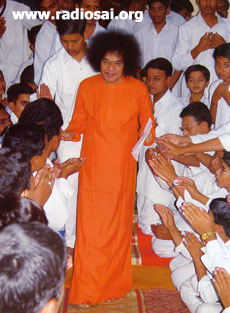 |
"I am yours , you are Mine." |
|
|
“A very unique process which takes place from within and without. What can be seen is how Swami ‘from without’ is trying to shape the students by way of His discourses, His informal talks and interactions. And this is only the tip of the iceberg. There are innumerable ways in which Swami works. I have heard any number of stories where a student is sitting in the darshan line and Swami just looks at him from the corner of His eye and it means so much to this student that He would have answered all the questions troubling his mind.
“Similarly, there is another student whom Swami doesn’t see and this boy feels so remorseful about something he has done, he takes a pledge he will never do it again. So there is something that happens deep within by Swami talking, not talking, looking, not looking, etc., which progressively opens up each student’s heart so that he becomes receptive to all the positive vibes of the system. There is clarity in him that the system is actually working for his benefit and shaping him in the right fashion.”
It is not only the Mandir sessions when boys get to interact with Bhagavan. They learn from Him in the Institute too. Ms. Rajeshwari Patel, a faculty member in the Anantapur campus of the Institute, recalls how Swami in the earlier days used to even “Sit inside the classroom when the classes were going on. He would sit behind and listen to the lecture and if some student turned around and looked back, He would say, ‘No, no, you listen to the teacher.’” |
Ethics from the Source
The first hour on every Thursday in the Institute is the Moral class hour and for many years Swami regularly addressed the students on topics of specific interest to them. When the School of Business Management, Accounting and Finance came into being in 1986, Swami’s visits to the Institute became even more frequent and there is no aspect of management that Bhagavan did not cover in His discourses, be it Marketing, Finance or Production. In fact, all His discourses are compiled into a beautiful volume called Man Management which is an ever increasing management epic and serves as a precious guidebook for the department.
Quality Management Redefined
Recalling a very revealing incident concerning the management students, Prof. Sudhir Bhaskar of the Business School, says,
“It was the summer of 1993. Management boys were in Whitefield looking for companies in Bangalore to do their projects. There was one batch of boys who were keen to an assignment on ISO 9001, which was then a buzz word in quality management in companies. One organisation wanted to know how it could incorporate ISO 9001 in its operations and a few boys took up that project. Those days Swami used to be in Whitefield. When the boys returned from the city in the evening, Swami would be waiting to ask, “Where did you go? What did you do?” etc. And then Swami would give individual attention and provide clarifications as to how they should do the analysis, how they should talk to people to obtain data, how to process the data, how to conduct them, and so on. It was a perfect feedback cum training session.
One evening, Swami asked this set of boys, ‘What are you doing?’ And they said, ‘Swami, we are doing ISO 9001 quality systems project.’ Swami then immediately asked, ‘What is Quality?’ While they were preparing to give textbook definitions, Swami said, ‘There is something called Total Quality Management (TQM), isn’t it?’ ‘Yes, Swami,’ the boys responded. Then Swami immediately turned to me and asked, ‘What is Total Quality Management?’ We were not teaching this subject then and I tried telling Swami how it is referred to in organizations, but Swami cut through all that. He said, ‘All this is not right.’ We then prayed, ‘Swami, please explain.’ After a split second, Swami said, ‘TQM is nothing but Thrikarana Shuddhi that is, Unity of Thought, Word and Deed.’ You should have seen – most of the senior devotees present almost fainted! Thrikarana Shuddi related to spiritual evolution - How can you run organizations based on Thrikarana Shuddhi? Of course, Swami then gave a few examples. After we returned from the Mandir, we discussed this – how TQM could be applied in Production, Marketing, Finance, etc. – in the hostel till ten o’ clock at night.
|
|
 |
Management Students with the Divine Manager |
|
The next morning we went to the Organization and in the discussion we mentioned, ‘Can we look at the purity of thought, word and deed and see if there is conformance to each one of them?’ You should have seen the faces of the top management. It was as if one million volts hit them!
Suddenly, they realized that their problems were because of not having this Thrikarana Shuddi. They have some idea, they have some concept, they don’t talk about it and they do something totally different. When they find this kind of disparity in thought, word and deed, obviously a lot of problems raise their hood and the company is torn apart.
They asked us, ‘Can you tell us something more about how this particular concept can be implemented?’ We explained to them how to implement the ISO 9001 system in a flawless manner. Today this is one of the very successful companies in Bangalore. In fact, the top management was so happy that the Chairman and Managing Director of the company came to Whitefield and told Swami, ‘You sent the boys. They solved our problem.’”
This is a classic example which goes to prove how values can be seamlessly applied to any discipline, coming directly from the Chancellor. And this is the sincere attempt in every classroom by every faculty member of the Institute. It is not only blending of physics and metaphysics or business and ethics which is conveyed in the colleges, there is also a very special course, or rather a forum, where students can openly discuss issues relating to applying values in practical life called the Awareness Course.
The Golden Triangle
“A frequently talked about topic in this Awareness program,” Sri Srirangarajan explains, “is what we call the Triangle of Life, which has basically three vertices – God or Almighty at the top and at the two other corners of the triangle, are the individual and the society. Normally we find that most of the problems in today’s world are because man lives a split life. We find an individual has one set of rules when working in the office and a totally different set of parameters which govern him when he is at home.
He goes to the temple and offers prayers but in his practical life he does not live in coherence with his religious beliefs. This triangle of life basically explains to the students how the individual is part of society and cannot live in isolation. And only when he considers the welfare of society as his own, will he be able to live a happy and peaceful life. |
|
|
In turn, the society is again a component of God and this goes on to explain that the individual is a part of society, society is part of nature and nature in turn is a limb of God. It is this interdependency that is dealt with in detail and students understand how one telescopes into the other. It might seem simple but it is a very complex and significant issue which would be very difficult for the students to get on their own.”
Self-Confidence – Life’s True Sustenance
Illustrating the whole idea, Srirangarajan says,
“In fact, it would be best to quote a particular incident about an alumnus of the Institute, who was facing a job interview when a member of the board asked him: ‘You seem to be coming from an institute where a lot of values are taught. You have a totally different type of system there; how do you really think you can fit into this corporate world of cut throat competition where it is all a business type relationship?’
This student intuitively replied, ‘Sir, just as a tyre of an automobile, once it is developed into the final product, is not tested on a smooth road but on a rough road and on demanding terrains to determine its durability, in the same way, our university makes us into ideal students to be tested in a wider world and not in a closed environment.’ The self-confidence the student exhibited was due to the firm grounding on values he had imbibed at the Institute. In fact, the impact it made on the Board Members was so great that they immediately hired this student for the job.”
The Hostel – A Model Mini Sai Family
While the students learn valuable lessons of life and living in the Institute and in the Mandir, the Hostel – the third dimension of the Integral Education Programme provides the right platform to actually experiment and be convinced of the viability of practicing the age-old principles in day to day life.
Mir Faisal Uddin Ali Khan, working in GE CAP in the USA sharing his views on this dimension of learning at the Hostel, says,
“When I first entered the hostel, I thought that I would have a room for myself. When I stepped in, I was directed to a big room. I congratulated myself, assuming that the entire room was for me. I was in for a rude shock. There were fourteen cupboards and by evening we had as many people. Well, out went my privacy via the window. It was a disgusting start I must confess, but as time passed, I learnt the importance of this design.
The Institute was teaching me in its own novel way to adapt to thirteen people with different cultures, religions, belief and even varied sleeping and eating habits. I must say that by the end of two years, the Institute, just by this design, taught me patience, flexibility and adaptability, the three important virtues of corporate survival.”
|
|
|
Stay together, Eat together, Live together - a Lesson of Brotherhood of Man |
|
The Hostel equips students with much more. You will be amazed to know that the Hostel is a self-sufficient world with over forty self-reliance departments. And every aspect of the Hostel is handled by the students. Right from the maintenance of electrical appliances, to cooking for boys who are sick, to handling the post and telegraph work, to publishing books on Swami, multimedia work, recording programmes or even managing the computer centre - everything is done by the boys. And from whom do they learn? From their seniors, as well as from dedicated teachers who live with them in the Hostel and function like substitute parents. Postgraduate boys, who have been working in the department for many years, take the lead and do the mentoring for the new boys. They teach them all they want to learn. This happens after the freshers choose their area of self-reliance. With so much to do in the Hostel in addition to the academic rigours and other cultural activities in the Mandir, it becomes, in the words of N Vivek, an alumnus currently working in Coimbatore, “So perfect a training for a manager.”
|
|
|
Student life is all about serving their brothers |
|
Excelling in all fields of life - Be it studying or sewing! |
H-O-S-T-E-L – Home Of Students To Envision Life
The triangle of Integral Education is complete when the theory and lessons learned in the classes and in the Mandir are applied and their value experienced in the real life of the hostel. But Bhagavan gives the students even greater opportunities to assimilate their precious lessons at a macro level through the big events of the Institute - the Annual Sports and Cultural Meet, the Convocation cultural fest, the mammoth Grama Seva project and the like.
The Sports Meet - Fostering Cooperation not Competition
Unlike other Institutions, Sports Meet Day, held yearly on January 11, is no occasion for competitive sports but rather an exhibition of the power of collective spirit and the beauty of coordinated endeavours. There are no 100 metre sprints or javeline throws or basketball duels on the Sports day. Sri Shashank, currently pursuing his Ph. D at the Institute, describes what really happens,
“It is all planned a month in advance. There are different events that are involved as a part of the sports meet. You need huge structures, you need special costumes, you need bikes and trucks to do stunts, you need a full fledged audio visual set up, you need maintenance and management of space in the ground, you need optimum time and resource management, and all this is exclusively done by the boys. Each one picks an item and an area he is good at and gives it his best. The whole hostel becomes one busy unit – the art room boys, the audio-visuals boys, the maintenance boys, all groups work in tandem. But the most beautiful thing in this well coordinated effort is that not one person thinks, ‘I am doing it’ or ‘it is my excellence’; it is always ‘we are doing it and doing it not for ourselves but as an offering to the Lord.”
|
|
|
|
The Sports Meet Day - an impressive display of devotion, dedication and daring |
It is this noble spirit which fires the boys’ enthusiasm to achieve great heights in whatever they do. The endless hours of work, the sleepless nights, the intermittent skipping of meals, etc., never become a deterrent. And Swami too responds just as enthusiastically or even more. In the words of Dr. Sainath, a former alumnus and currently a faculty member in the Physics Department,
“Many times there would be injuries in the sports meet and I remember how He would even go unannounced to the Hostel to see what the extent of the injury was. That was the very close proximity that He awarded. The programme would include a lot of games, sports and various other items. And He would watch some of the items a couple of items before and if some of them were really adventurous and nice, He would once again call some guest and ask the boys to perform. In spite of seeing the programmes earlier, on the day of the sports meet, He would sit like a child in awe of what we were doing. He would pretend as if He knew nothing and tell the guests, ‘see this’, ‘see this’. You could see the excitement in Him, just like a proud mother.”
|
|
|
The Lord has come to watch the sports day preparations |
|
A proud Mother with Her children |
Swami’s love, coupled with the students’ enthusiasm and devotion, is what makes the annual sports meet a grand spectacle to behold. By the end of the Sports Meet, they have toned their bodies, sharpened their skills and displayed brilliant talent, but an even more enriching upshot is that their hearts are now suffused with greater love for the divine than ever.
God Assigns a Role for Each One
If the Sports Meet is an exciting mind-body extravaganza, the drama performed by the students on Convocation Days is an unparalleled opportunity for the participants to observe Bhagavan at close quarters and learn lessons of life directly from Him. Bhagavan involves Himself completely in the drama every year. His penchant for the use of theatre to communicate important social values has remained the same from His childhood days when He scripted, directed and staged the famous play Cheppinattlu Chesttara (meaning, Will You Do As You Said?). In the words of Dr. Sai Giridhar, an alumnus and currently a faculty member in the Business School, “Swami is very meticulous. He is extremely particular about the way the dialogue is delivered, the way the people act, their postures, etc. I think that is what makes dramas different from the boys' perspective. It gives so much insight into playing the role to its perfection.”
“There are many things that the people may ignore,” continues Dr. Sai Giridhar, “for instance, there was a drama which was titled Bhaja Govindam. The person who was acting as a rich man was also a disciple and he said: “Money! Money! Money! What is the role of money?” And Swami said: 'The person who is playing the role of a rich man should exhibit the qualities of a rich man. The way he conducts himself should be on par with his part. So the person who wants to imply ‘what is money after all’ should be humble, there should be a lot of conviction in what he says which should be reflected in his dialogue delivery.' Every line and every detail was closely scrutinised by Bhagavan."
|
|
Swami with the boys who staged the Bhaja Govindam drama |
This holds true not only for the actors on stage but also for the almost double in number students who work backstage handling various aspects of the presentation, whether it is lights, costumes, sets, or audio-visuals. Swami often spends a lot of time with this inconspicuous group guiding them, encouraging them and correcting them.
Recalling an enlightening experience, Sri B N Narasimha Murthy, currently Warden of the Brindavan Campus of the Institute, says,
“When for the first time we had our drama presented in the Poorna Chandra Auditorium, we had only four frames with curtains made as we only had that much material available. Three days before we put up the performance, I was telling Dr. Pallav, (another faculty member), if there were six frames, it would look much better, as that would give more scope for the actors in terms of proper entries and exits. But since there was no more material available, Dr. Pallav said, ‘Maybe we will have that next year.’ And I never discussed this again with him or any other faculty or even Swami.
That week, Swami came to the auditorium, saw the four frames and said, 'If there were two more frames, it would be nice.' Dr. Pallav immediately looked at me as if asking, ‘Did you tell Swami about it?’ After Swami left, I told him it was something divine and I had never spoken about this to Him. But Dr. Pallav was worried. There were only two days left till the performance. He wondered, 'How are we going to do this?' Both of us decided that since Swami has said it, we would give it a fair try. And so, the next moment we were in Robin’s workshop. When we reached there we were amazed. He had just two frames in the perfect way that we wanted! We could not believe this. We asked him, 'Why did you make these?' He said, 'I do not know, Sir. Somebody wanted them, so I made them, but it seems they don’t want it now. They are yours if you like.'” It is an event which is etched in Dr. Pallav’s and Sri Narasimha Murthy’s memory forever.
“The fact that goes with the dramas is that it is not the final presentation of the drama that matters. It is the interaction with Bhagavan,” says Dr. Sai Giridhar. “Bhagavan would come to the Institute and watch the drama. He might have seen the drama n number of times. He may have watched it sixteen times, but the seventeenth time, He gives it the same amount of attention. Not merely the dialogue delivery but literally every aspect of the drama.”
|
|
|
Backstage, Swami pays attention to every detail |
|
The actors with the DIRECTOR! |
Bhagavan is perfection personified and through various means and methods He raises all the participants to that level. A great learning experience filled with precious divine insights – that is what the drama is for all the students involved.
Grama Seva – To Love and Serve
In 2000, the millennium year, Swami blessed the Integral Education programme of the Institute with a new dimension to Seva, by launching what is now known as Grama Seva. Since then, every year, for about ten days, the entire Institute, staff and students, get totally involved in going to hundreds of villages and serving tens of thousands of rural folk. They do this by actually going to their homes, speaking to them, performing bhajans in their villages and then offering them sweets, food and new clothes. For the villagers it is as if Bhagavan has come to their doorstep to shower His love and blessings. For the students, it is a learning experience like no other. Apart from this being a grand exercise in planning and management, the Warden, Sri B N Narasimha Murthy, says,
“Most of the students who come from cities haven’t visited villages even once in their lives. When they see the poverty stricken conditions of the villagers, they realise the import of Mahatma Gandhi’s statement, 'India lives in her villages,' and there is much more to the country than the metros like Delhi , Mumbai, Kolkata or Bangalore. The impression on the students is deep and their reaction is spontaneous. They immediately reach out to these people with empathy in their hearts and serve them with great sincerity.”
|
|
On a spiritual pilgrimage to the distant villages |
Jettisoning personal comfort overboard for love of God's work
|
|
|
Love is all about giving |
Staff and students attend to an elderly couple |
Though Grama Seva in its current form was introduced by Bhagavan six years ago, even prior to that it has always been an integral part of the Institute curriculum in some form or the other. In fact, Swami Himself visited two very remote villages near Puttaparthi as early as 1985 along with a big group of students to personally demonstrate the values of rural service and self-reliance. On that historic occasion, Swami went to the extent of saying, “These two villages are My two eyes.” We have a very special account of this visit of Bhagavan in our supplementary article by Prof. G Venkataraman entitled, “A Peep into the Eyes of God.”
To read the special article by Prof. G Venkataraman on Grama Seva and Swami's historic visit to the
villages of Ammagondapalem and Ragepalli in 1985, click here. |
Many might ask, “Can a once-a-year visit to the villages really make any difference?” The truth of the matter is that for the villagers, Grama Seva is an annual reminder that Swami, who looks after them in so many ways, through His free Hospitals, the all-year supply of safe drinking water and now the recently launched Mobile Hospital, that same Swami is now greeting them in their homes by sending His students with a Message of Love. For the students, who live by the concept of service in the Hostel and discuss it comprehensively in the college, going to the villages year after year during their stay in the Institute develops in them a new sensitivity to India and her real problems.
Twenty Five Years of Inculcating Holistic Human Excellence
Twenty-five years have passed since the University came into being and many more years have flowed under the bridge of time since Swami inaugurated the first Sathya Sai College in Anantapur (for women) in 1968. The Institute has indeed changed in a myriad ways over the years.
Where there were overhead projectors, now there is a video conferencing facility; where there was a simple ground for sports now there is a cricket stadium which has hosted international tournaments and in a few weeks the Institute will have a world-class indoor stadium; where there were in-house faculty or faculty from local colleges, now there are visiting professors from Harvard and Cornell; the Nd YAG laser (acronym for Neodymium-doped Yttrium Aluminum Garnet) non-linear lab in the Physics Department of the Institute, is one of the best in India in the area of photonics (that is, science and applications based on laser light); its annual Convocation ceremonies over the years have been graced by three Presidents, three Vice-Presidents, and three Prime Ministers of India, including other eminent personalities and educationists. This year, President Kalam is coming for the second time; the students secure top ranks in national level examinations like GATE (Graduate Admission Test for Engineering) in spite of being engaged in various co-curricular and extra-curricular activities throughout the year (in fact, in 2004 one student obtained the first rank in Physics); the NAAC committee (set up by University Grants Commission) which gave A++ rating to the Institute in 2002 (the highest awarded to any University In India), also mentioned in their report – “The Committee strongly feels that the Institute must be recognized for promotion of peace by UNESCO.” Year after year, the Institute has grown in grandeur and serenity and its story has achieved greater glory. |
|
|
Swami with President Dr. Abdul Kalam during
Institute Convocation in 2002 |
|
Yes, the Institute has undergone a lot of transformation. Every change has only strengthened its wings and facilitated its faculty in delivering the best to society – year after year providing the nation with groups of young adults with a holistic view of life who believe that character and virtues are more powerful than any other force on earth.
If the Institute remains passionately focussed on its objective of ‘building character’ in spite of the changing times in the modern era, it is because there is one thing which has never changed in the Institute. And that is the Love of Bhagavan towards His students. He may not be giving students the amount of time He used to in the 1970s or 1980s, largely because of the various mega service projects, but still He gives students more time than all others put together. He still takes them to Kodai Kanal, now by plane rather than by bus. He still finds plenty of time to listen to them chant the Vedas, bless them on their birthdays, interact with them in the Mandir and Bhajan hall, watch their hundreds of cultural programmes all round the year and celebrate all the festivals with them. Truly, that which is connected with the ephemeral world is always subject to change but that which is connected with divinity, remains constant forever.
The Most Prized Relationship In the World
Prof. Sudhir Bhaskar narrates a very moving anecdote which amply demonstrates this aspect of Bhagavan. “It was one evening in the Mandir portico”, he says.
“Prof. Anil Kumar, Mr. Bhagya and I were seated along with the boys. Some students were desperately trying to give letters to Swami but for some reason Swami avoided them.
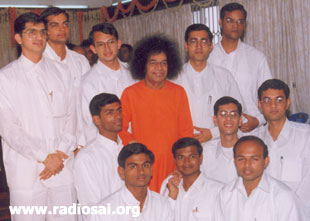 |
"I am always taking care of you -
now and hereafter" - Baba |
|
Prof. Anil Kumar then took the liberty of saying, ‘Swami, please take their letters.’ Swami asked, ‘Why should I take?’ Prof Anil Kumar replied, ‘Swami, there must be something very important and urgent, maybe there is some emergency. They are trying very hard to share it with you.’ Listening to this plea of Prof. Anil Kumar, the statement that Swami made was epoch-making and mind-boggling. The whole world should have listened to it. It continuously rings in my ears till this day. Swami said,
‘I need not take their letters to know their problems. You are saying there is an emergency? You feel only after it is brought to my notice, will I intervene? Let me tell you, now and forever – My students, will never have an emergency. Even before the emergency can come towards them I would have already intervened. Don’t have the impression that I intervene only when it has been brought to my notice. Students, I am always taking care of you – now and hereafter.’”
|
|
Nothing more need be said about the phenomenal love that Bhagavan has towards His students. Nothing more need be added to explain how the students are so fortunate to have stepped into this hallowed Institute. “The Institute,” as Prof. V K Gokak, the first Vice Chancellor of the University said, “is extremely fortunate to have as the Chancellor an Avathar who is the Chancellor of the Universe itself!”
Sai Alumni – Beacons of His Love
No matter what corner of India or the world the alumni of this Institute have gone to, they have always carried this light of His love in their hearts and shared it with as many as possible. A group of graduates in Mumbai have adopted a neighbouring impoverished village and with the support of a multinational bank have executed a wonderful project providing safe drinking water to hundreds of villagers. Every weekend, alumni in various cities come together to do free medical camps in rural areas and educate the people about sound healthcare. As the scare of dengue epidemic still continues in various parts of India, alumni in Andhra Pradesh regularly go the villages providing vaccines and educating them on preventive healthcare. When a massive earthquake struck the state of Jammu and Kashmir in 2005, a team of students from different states were the only group, apart from the Army, who reached out to the victims, braving rough terrain and inclement weather, to rehabilitate and construct new houses for the shelter less. In the very cold nights of winter, when people sleeping on the streets and under trees are shivering and writhing in discomfort, the alumni in Andhra Pradesh search out these homeless and cover them with woollen blankets. We can go on and on.
|
|
|
Sai Alumni attend to sick children at a medical camp |
|
The Alumni practice "Nara Seva is Narayana Seva" |
|
|
|
Sai Alumni ensuring warmth for the cold winter nights... |
|
Attending to the elderly and sick |
Not only this, if the several Institutions set up by Swami – be it the free Hospitals in Prasanthi Nilayam or Bangalore, the Books and Publications Trust, the Radio Sai Global Harmony, the Higher Secondary School, the Colleges or the apex body, the Sri Sathya Sai Central Trust – run 24x7 like a well-oiled engine, it is because there are nearly a hundred alumni of the Institute who have stayed back in the ashram forsaking a professional career and a prosperous life to be directly a part of His mission. For them, it is the greatest fulfilment of their lives.
To save its fate today, humanity needs individuals who possess the right spiritual balance of knowledge and skill. This is what the Institute has delivered with increasing vigour for almost three decades. Now, it is time for the rest of the world to emulate this sacred seat of learning where the ancient and modern gel so well and prove that value education at the university level is not a utopian idea, but one whose time has come and can be postponed no longer.
- Bishu Prusty
Heart2Heart Team
Dear reader, how did you like this cover story? Was it informative and inspiring? Do you have any suggestions for our future cover stories? Please let us know at h2h@radiosai.org. Please mention your name and country when you write to us. Thank you for your time.















